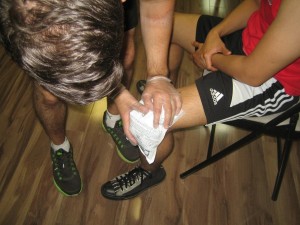Skin burns are often linked with heat but severe cold from cold therapy can lead to an ice pack burn in a similar manner. If the individual has used an ice pack in managing muscle sprains or strains, it is vital to avoid direct exposure of the pack on the skin during application.
The freezing temperature of an ice pack straight on the skin can trigger a localized area of damage on the tissues known as an ice pack burn or frostbite. This injury can be prevented by placing a clean cloth or towel between the skin and the ice pack.
Warming the skin
Warm the area that came in direct contact with the ice pack to prevent an ice pack burn or frostbite from developing that might be severe enough to damage the blood vessels. An individual might have an ice pack burn if there are blisters, skin appears yellowish-gray in color, painful with a burning sensation or feels itchy or numb.
The normal body temperature must be restored in a gradual manner to avoid burns that can cause more damage. You can soak the damaged limb in warm water, apply a warm compress or wrapping with blankets to restore the sensation to the area with an ice pack burn.

If a warm soak is chosen, the water temperature should be at least 104 degrees F but not higher than 108 degrees. A 20-minute soak can provide an improvement and the ice pack burn starts to tingle and turn reddened as the skin thaws.
Blister treatment
The presence of blisters is an indication of an ice pack burn just like with heat burns. The proper management of blisters can help avoid infection and other complications. Removal of the excess tissue or de-roofing of the blister will allow the doctor to effectively dress the wound.
In some cases, an open wound can develop due to incorrect usage of an ice pack. Treat the wound just like any wound with an antibiotic ointment or petroleum jelly and cover with gauze bandage to keep the area moist and free from infection. In case the blister is large in size, there is a need to change dressings and re-apply first aid for up to 10 days.
When to seek medical care for an ice pack burn
An ice pack burn that does not start to tingle, burn or regain its pinkish hue might be an indication of extensive damage to the blood vessels and muscles below the skin.
In case the burned area remains numb with skin that feels cold and hard, a doctor should be consulted. A doctor must be consulted so that the right treatment can be started to avoid any complications such as nerve damage and gangrene.

